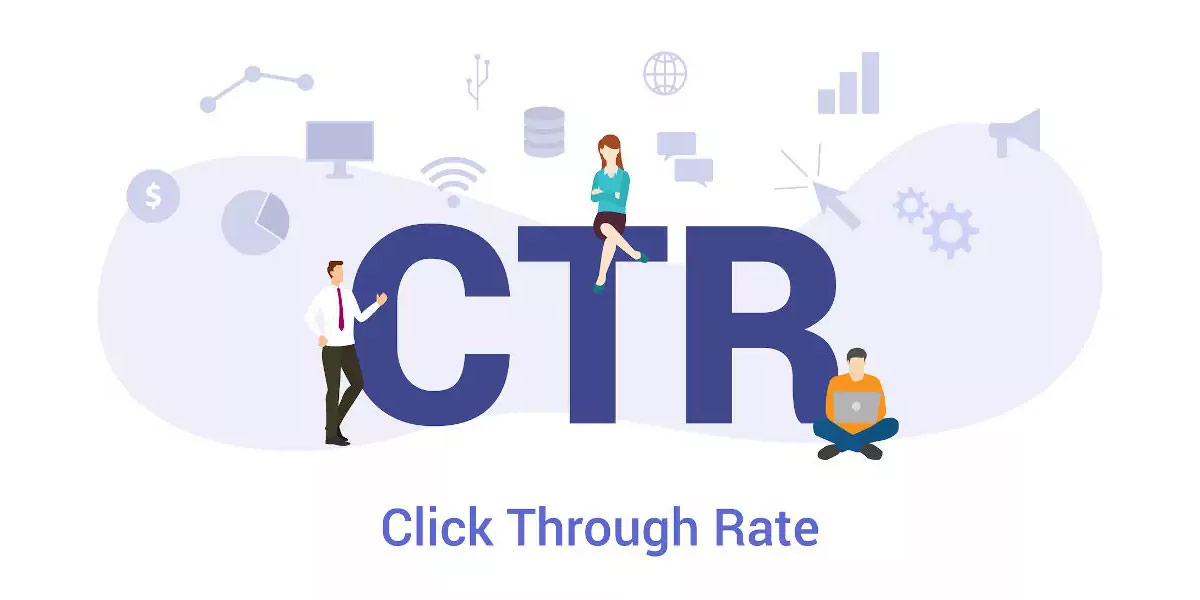What is Click-Through Rate (CTR)?

If you’re familiar with digital marketing, then you’re likely aware of the importance of click-through rates (CTR). CTR is a vital metric that measures the percentage of clicks that an ad, email, or webpage receives about the number of impressions it generates. The higher the CTR, the better the performance of your marketing efforts.
In this comprehensive guide, we’ll dive into everything you need to know about click-through rates, including what they are, how they work, and how you can optimize them to improve your digital marketing campaigns.
What is a Click-Through Rate (CTR)?
A click-through rate (CTR) is a metric that measures the percentage of clicks that an ad, email, or webpage receives about the number of impressions it generates. Essentially, CTR is the ratio of clicks to impressions. For example, if an ad received 100 impressions and 10 clicks, its CTR would be 10%.
CTR is used to measure the effectiveness of digital marketing efforts. It provides insight into how engaging and relevant an ad, email, or webpage is to its target audience. By measuring CTR, marketers can determine which campaigns are performing well and which ones need improvement.

What is a Click-Through Rate (CTR)?
How Does Click-Through Rate Work?
The click-through rate is calculated by dividing the number of clicks an ad, email, or webpage receives by the number of impressions it generates. For example, if an ad received 1,000 impressions and 50 clicks, its CTR would be 5%.
Why is Click-Through Rate Important?
Click-through rate is important because it measures the effectiveness of digital marketing efforts. A high CTR indicates that an ad, email, or webpage is engaging and relevant to its target audience, while a low CTR suggests the opposite. By measuring CTR, marketers can identify which campaigns are resonating with their audience and which ones need improvement.
What is a Good Click-Through Rate?
The average click-through rate varies depending on the industry and the type of digital marketing campaign. However, a good click-through rate is generally considered to be above the industry average. According to a study by WordStream, the average click-through rate for Google Ads is 1.91% on the search network and 0.35% on the display network.

What is a Good Click-Through Rate?
Factors that Affect Click-Through Rate
Several factors can affect the click-through rate, including:
1. Ad relevance
The relevance of an ad to its target audience is a significant factor that can affect CTR. If an ad is relevant and engaging to its target audience, it is more likely to generate clicks.
2. Ad placement
Ad placement can also affect CTR. Ads that are placed in prominent locations, such as above the fold, tend to generate more clicks than those that are placed lower on the page.
3. Ad copy
The copy of an ad can also affect CTR. Ads that have clear and compelling copy tend to generate more clicks than those that are unclear or unconvincing.
4. Call-to-action (CTA)
The call-to-action (CTA) in an ad can also impact CTR. A clear and compelling CTA that urges the viewer to take action is more likely to generate clicks than a weak or vague CTA.
5. Targeting
Targeting the right audience is crucial for generating high CTRs. Ads that are targeted to the wrong audience are unlikely to generate clicks.
6. Ad format
The format of an ad can also affect CTR. Visually appealing ads, such as video ads or carousel ads, tend to generate more clicks than static image ads.

Factors that Affect Click-Through Rate
How to Improve Click-Through Rate
Improving click-through rates requires a thorough understanding of the factors that affect CTR. Here are some tips to help you improve your CTR:
1. Optimize your ad copy
Your ad copy should be clear, concise, and compelling. It should highlight the benefits of your product or service and include a strong call to action that urges the viewer to take action.
2. Test different ad formats
Try testing different ad formats to see which ones generate the highest CTR. For example, you could try running a video ad campaign and compare its performance to a static image ad campaign.
3. Target the right audience
Make sure that your ads are targeted to the right audience. Use audience targeting options such as location, demographics, and interests to ensure that your ads are reaching the right people.
4. Use ad extensions
Ad extensions, such as site link extensions and callout extensions, can help to improve CTR by providing additional information about your product or service.
5. Monitor and adjust your campaigns
Regularly monitor your campaigns and make adjustments as needed. For example, if you notice that a particular ad is underperforming, try adjusting the targeting or ad copy to see if it improves CTR.

How to Improve Click-Through Rate
Best Practices for Optimizing Click-Through Rates
Here are some best practices to follow when optimizing click-through rates:
1. Use compelling headlines
Your headlines should be attention-grabbing and highlight the benefits of your product or service.
2. Include clear and compelling CTAs
Your call to action should be clear and compelling, urging the viewer to take action.
3. Test different ad formats and targeting options
Try testing different ad formats and targeting options to see which ones generate the highest CTR.
4. Use ad extensions
Ad extensions can help to improve CTR by providing additional information about your product or service.
5. Monitor and adjust your campaigns
Regularly monitor your campaigns and make adjustments as needed.

Best Practices for Optimizing Click-Through Rates
Measuring and Tracking Click-Through Rate
Measuring and tracking click-through rates is essential for optimizing your digital marketing campaigns. Here are some tools you can use to measure and track CTR:
1. Google Ads
Google Ads provides detailed reports on CTR, allowing you to track the performance of your campaigns.
2. Google Analytics
Google Analytics can help you track CTR on your website, allowing you to see which pages are generating the most clicks.
3. Email marketing platforms
Email marketing platforms such as MailChimp provide detailed reports on email CTR, allowing you to see which emails are generating the most clicks.

Measuring and Tracking Click-Through Rate
Click-Through Rate vs. Conversion Rate
Click-through rate and conversion rate are both important metrics for measuring the effectiveness of digital marketing campaigns. While CTR measures the percentage of clicks an ad, email, or webpage receives about impressions, conversion rate measures the percentage of conversions that result from clicks.
In other words, while CTR measures the success of your ad in generating clicks, conversion rate measures how successful your ad is in turning those clicks into actual sales or leads.
A high CTR doesn’t necessarily mean a high conversion rate. It’s possible to generate a lot of clicks on your ad, but if your landing page isn’t optimized to convert those clicks into sales or leads, then your conversion rate will be low.
To improve your conversion rate, you need to focus on optimizing your landing page, making sure it is aligned with your ad copy and provides a clear and easy path for the user to take action.
Click-through rate in email marketing
In email marketing, the click-through rate measures the percentage of recipients who clicked on a link in your email. It’s an important metric for measuring the effectiveness of your email campaigns and how engaged your subscribers are with your content. A high click-through rate indicates that your subscribers are finding your content relevant and valuable.
To improve your email click-through rate, make sure your emails are well-designed and visually appealing, with clear calls to action and relevant content that speaks to your audience’s interests and needs.
Click-through rate in search engine marketing
In search engine marketing, click-through rate measures the percentage of clicks on your ad about the number of times it was shown (impressions). It’s an important metric for measuring the effectiveness of your ad copy and targeting.
To improve your search engine marketing click-through rate, make sure your ad copy is relevant and compelling, with clear calls to action and targeted keywords that align with your landing page.

Click-through rate in search engine marketing
Click-through rate in social media marketing
In social media marketing, click-through rate measures the percentage of clicks on your ad or post about the number of times it was shown (impressions). It’s an important metric for measuring the effectiveness of your social media campaigns and how engaged your audience is with your content.
To improve your social media click-through rate, make sure your content is relevant and visually appealing, with clear calls to action and targeted messaging that speaks to your audience’s interests and needs.
Click-through rate in display advertising
In display advertising, the click-through rate measures the percentage of clicks on your ad about the number of times it was shown (impressions). It’s an important metric for measuring the effectiveness of your ad design and targeting.
To improve your display advertising click-through rate, make sure your ad design is visually appealing and eye-catching, with clear calls to action and targeted messaging that aligns with your landing page.
Click-through rate in video marketing
In video marketing, the click-through rate measures the percentage of clicks on your video about the number of times it was shown (impressions). It’s an important metric for measuring the effectiveness of your video content and how engaged your audience is with your message.
To improve your video marketing click-through rate, make sure your video content is relevant and visually appealing, with clear calls to action and targeted messaging that aligns with your audience’s interests and needs.
Click-through rate in mobile marketing
In mobile marketing, click-through rate measures the percentage of clicks on your ad or message about the number of times it was shown (impressions) on mobile devices. It’s an important metric for measuring the effectiveness of your mobile campaigns and how engaged your audience is with your content.
To improve your mobile marketing click-through rate, make sure your content is optimized for mobile devices, with clear calls to action and targeted messaging that speaks to your audience’s interests and needs.

Click-through rate in mobile marketing
Conclusion
Click-through rate is an essential metric for measuring the effectiveness of your digital marketing campaigns. By understanding the factors that affect CTR and following best practices for optimization, you can improve the performance of your ads and generate more clicks.
However, it’s important to remember that the click-through rate is just one part of the equation. To truly measure the success of your digital marketing campaigns, you need to also consider conversion rate and other metrics that reflect how well your ad is converting clicks into actual sales or leads.
FAQs
What is a good click-through rate?
A good click-through rate varies by industry and ad format, but generally, a CTR above 2% is considered good.
How can I improve my click-through rate?
You can improve your click-through rate by optimizing your ad copy, testing different ad formats and targeting options, using ad extensions, and monitoring and adjusting your campaigns as needed.
What is the difference between click-through rate and conversion rate?
Click-through rate measures the percentage of clicks an ad receives about impressions, while conversion rate measures the percentage of conversions that result from clicks.
What tools can I use to measure and track click-through rates?
Tools like Google Ads, Google Analytics, and email marketing platforms like MailChimp can help you measure and track click-through rates.
Why is the click-through rate important?
Click-through rate is important because it measures the success of your ad in generating clicks, which is the first step towards converting those clicks into actual sales or leads.

